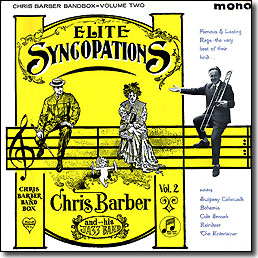 |
||
LP recorded and released in 1960; Reissued as a CD with bonus tracks on Lake Records in 2011. In his notes on the back of the LP cover, Chris Barber wrote: "Ragtime is a musical idiom that was popular between 1890 and 1920 (having no connotation whatsoever with a bandleader named Alexander!). It had a very great influence on jazz development but has been sadly neglected in recent years.... We had the honour of visiting New Orleans to give a concert in 1959, and we were fortunate to find a collection of original Ragtime sheet music at Bill Russell’s little shop in the French Quarter, thus enabling us at last to prepare and record some authentic Ragtime-style jazz. All the numbers on this LP except Georgia Cakewalk and St. George's Rag come from this collection.... The descriptions of the tunes, the illustration and the panel underneath the title all taken from the original Stark Publishing Co. sheet music, as is the cover of Elite Syncopations". Right from their outset in 1954 -- and before that if you want to count the embryo bands that led to the formation of Ken Colyer's Jazzmen and that band's evolution into Chris Barber's Jazz Band -- Chris and the band (but mainly Chris himself, I think) were innovators. Not only did they anticipate various trends but in many cases they set the trend by inventing it in the first place! The first of the two best-known examples began with the band's skiffle group, the recording and release of Rock Island Line, the enormous influence of Lonnie Donegan, and the explosion of skiffle as both a commercial form of music and an amateur craze in the late-1950s. The second was the band's practice of inviting to Britain some of the most illustrious and influential names on the North American blues and gospel scenes: Sister Rosetta Tharpe, Sonny Terry and Brownie McGhee, and Muddy Waters with Otis Spann -- all in the space of less than twelve months in 1957 and 1958. Several others followed, and together with the Barber Band they helped to foster the emergence of a vibrant British blues and rock scene. In the late 1960s and early 1970s, another mini-craze emerged in the pop music world: ragtime. This happened largely because of the use of the ragtime tune The Entertainer as the theme song in the Paul Newman/Robert Redford hit movie, The Sting. I think it's fair to say that few patrons and fans were aware that the song had not been written for the movie but had been around for about 70 years! I doubt that Chris would claim any part in stimulating this third trend, but there is no doubt that, once again, he and his band were "ahead of the curve", not only by including rags in their repertoire since the Colyer days but also by recording, in 1960, a 12-inch LP, Elite Syncopations, devoted entirely to ragtime music. The story of how the music was discovered is told briefly by Chris in the quote from the original LP cover at the top of this page, and you can listen to a short sound clip of Chris introducing one of the tunes, The Peach, on a radio programme. For the most part, the LP featured the standard six-piece line-up of the band as it was at the time, but even within the album itself there was innovation: three of the tunes consisted of a multi-tracked Barber trombone accompanied by just the rhythm section. One of these, Bohemia Rag, is excerpted below. |
||
| Music: The Entertainer || Bohemia Rag || St. George's Rag || The Peach | ||
| The Barber website includes further information about this LP, including the 2011 CD re-issue on Lake Records, as well as large-scale scans of several vinyl LP re-issues. | ||
Previous cover || Next cover || Covers page |
||
